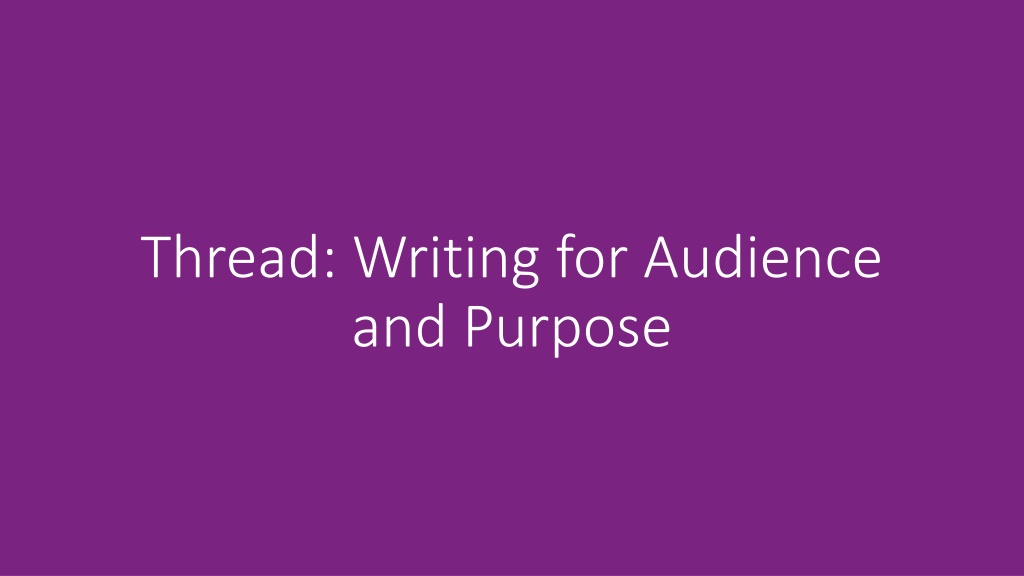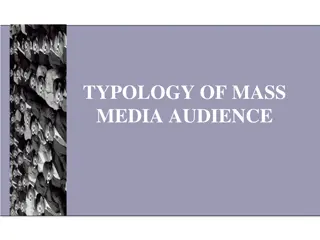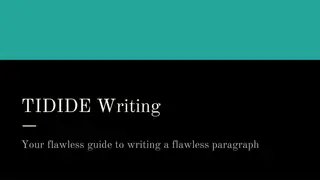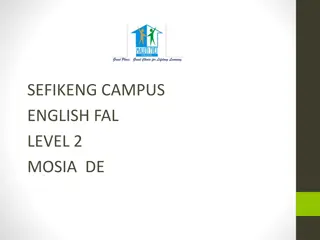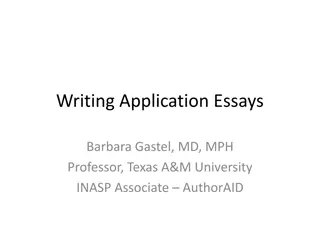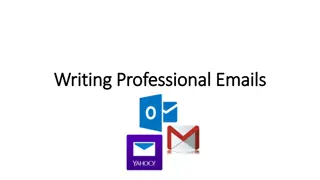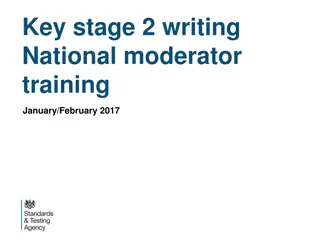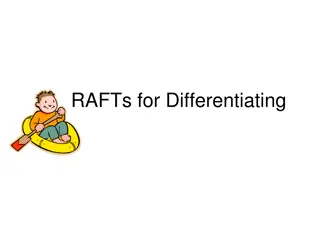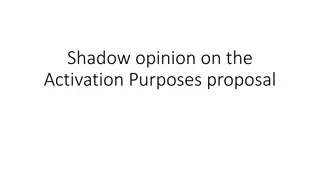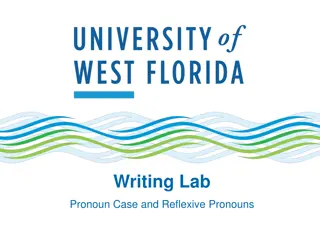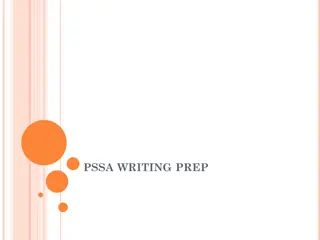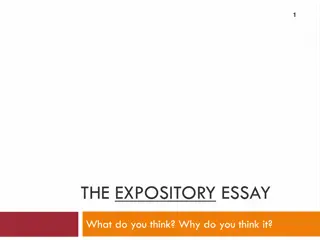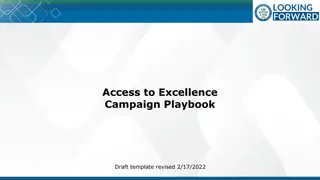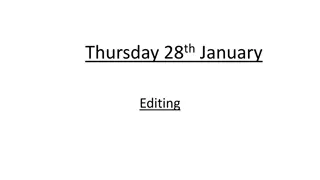Mastering Writing Skills for Various Audiences and Purposes
Enhance your writing skills by learning how to write effectively for different audiences and purposes. Develop the ability to choose appropriate vocabulary, adapt style, and structure, use correct punctuation, and engage readers with thoughtful content. From basic handwriting to advanced composition techniques, this thread guides you through the progression of writing proficiency, emphasizing clarity, coherence, and fluency.
Download Presentation

Please find below an Image/Link to download the presentation.
The content on the website is provided AS IS for your information and personal use only. It may not be sold, licensed, or shared on other websites without obtaining consent from the author. Download presentation by click this link. If you encounter any issues during the download, it is possible that the publisher has removed the file from their server.
E N D
Presentation Transcript
Thread: Writing for Audience and Purpose
Thread: Writing for Audience and Purpose Progression Step 1 Progression Step 2 Progression Step 3 Progression Step 4 Progression Step 5 To write legibly and fluently. To plan, draft and present work effectively, including in a range of digital contexts e.g. thumbnails and language preferences. To make appropriate vocabulary choices including subject specific vocabulary and use them to communicate effectively. To adapt writing style and structure to suit the audience, and make appropriate vocabulary choices including idiomatic language and syntax for fluency and clarity ensuring appropriate register. To use strategies to spell familiar and unfamiliar in context, such as subject specific words. To use a range of simple, compound and complex sentence structures accurately. To use paragraphs to give coherence. To use an increasing range of connectives to organise ideas in sentences, paragraphs and whole texts. To use a range of punctuation accurately, including colons, semi-colon and parenthesis. To adapt my writing style, choosing and using the best structures for different contexts and purposes e.g. explain, describe, persuade and discuss. To use summary, discussion of issues, detailed explanations and logic when covering a topic. To write about thoughts, feelings and opinions , showing empathy and respect, using a range of techniques e.g. emotive language, hyperbole, choice of pronouns to show impact. To respond to others points of view, seeking clarity, structuring arguments, summarising and explaining what I have heard, read or seen. To reflect, edit and redraft independently to improve quality of written expression. To demonstrate an ability to use punctuation for effect. To have command of a variety of registers, from colloquial to highly formal. To be able to use a wide range of synonyms and antonyms or alternative expressions. Handwriting: To communicate by mark making. To recognise mark making materials. To show some control in mark making. To produce some recogniseable letters. To draw symbols and write letters and words. To form letters correctly using appropriate grip. To be able to make simple choices based on my audience (e.g. Letter to the Headteacher, letter to a friend). I can write legibly. I can write single and multi-clause sentences including connectives, adjectives and adverbs. I can begin to use a range of familiar strategies and tools to improve my writing. Use familiar punctuation including capital letters, full stops, question marks, exclamation marks etc. Beginning to mark clauses and phrases e.g. after a fronted adverbial Later that morning, we visited the castle. To know that different forms affect structure (eg. letter / newspaper). To know what a paragraph is and to begin to use paragraphs in my writing. To be able to use the features of specific forms / text types e.g. letter, formal, informal, reporting, diary and dialogue. I can organize my writing into a logical sequence. My vocabulary is increasingly, varied, imaginative and precise. To be able to choose between writing in first person, third person and direct address depending on purpose and audience. To be able to use familiar punctuation for clarity of communication. To write legibly and fluently. To plan, draft and present work effectively, including in a range of digital contexts. To adapt writing style and structure to suit the audience, and make appropriate vocabulary choices including idiomatic language and syntax for fluency and clarity ensuring appropriate register. To use the appropriate form of a variety of words e.g. past, present, negative forms. To use knowledge of letter sounds and patterns in my spelling, including roots, suffixes and plural forms correctly. To use strategies to spell polysyllabic, complex and irregular words in context, such as subject specific words. To use a range of simple, compound and complex sentence structures for emphasis and effect. To use paragraphs and make links between them. To use an increasing range of connectives to organise ideas in sentences, paragraphs and whole texts. To use a range of punctuation accurately, including apostrophe for possession. To write a comprehensive account of a topic, theme or viewpoint. To use and adapt different structures within writing e.g. reporting an event, investigation or experiment. To write about thoughts, feelings and opinions, showing empathy and respect. To respond to others points of view, seeking clarity, structuring arguments, summarising and explaining what I have heard, read or seen. To reflect, edit and redraft to improve quality of written expression. To demonstrate an ability to use punctuation for effect. To be able to move away from spoken language patterns and use those only found in written expression (such as appositives). To be able to write logically and coherently to meet the writing requirements of a range of subjects. To know and be able to use academic conventions in writing. Understanding and knowledge of the concept of a thesis, and the ability to construct a thesis statement. To be able to write at pace, fluently and legibly. To be able to convey sophisticated meaning through inference or implication. To be able to identify and use humour and comedic devices such as satire. To be able to move between registers within the same text. To be able to choose between passive and active voice depending on the intention of the writing. To be able to use the full range of punctuation for deliberate effect, including deliberate use of fragment sentences. To know and accurately employ appropriate subject specific vocabulary. To understand the process of nominalisation switching from a verb based expression into a noun or noun phrase and its place in academic writing. Spelling: To write own name with appropriate upper and lower case letters. Use correct initial consonant by beginning to apply phonic knowledge. To write simple, regular CVC words. KNOWLEDGE and SKILLS Punctuation: To use finger spaces to separate words. To show an awareness of how capital letters and full stops are used. Ideas and Opinions: To orally share my ideas and feelings and express likes and dislikes. To describe objects and events. To build and extend my vocabulary. Audience & Purpose: Can imitate adults writing and understand the purpose of writing. To be aware of different purposes for writing. To contribute to shared writing for different audiences and purposes. To communicate using a range of media. To use familiar words and phrases and experiment with vocabulary.
Thread: Writing for Audience and Purpose Progression Step 1 Progression Step 2 Progression Step 3 Progression Step 4 Progression Step 5 Whole text: Context Colloquial Register Transactional Paraphrase Direct and reported speech Sincerely Faithfully To whom... Handwriting Pencil Pen Grip Letters Froggy Legs (Pincers) Phonics sounds Capital letter Full stop Finger spaces First name Surname Regular CVCs Whole text: Formal Informal Address Introduction Middle Ending/conclusion Structure Paragraphs Express Extend Dialogue First person Third person Draft Edit Legible Whole text: Line of argument Thesis Thesis statement Embedded evidence Footnotes References Irony Parody Satire / satirical Text level: Formal Informal Tone Opinion Justification Recount Report Information Instruction Explanation Persuasion Description Imaginative Narrative Captions Headings Fonts Timeframe Sentence level: Clause: main/independent, subordinate/dependent Simple Compound Complex Sentence level: Active voice Passive voice Word level: Noun phrase Nominalisation Sentence level: Subject Verb Connective Openers Sentence level: Declarative / statement Interrogative / question Imperative / command Tense Punctuation: Comma (in relation to clause) Semi colon Inverted comma, Ellipses Hyphen Parenthesis VOCABULARY Connectives: FANBOYS Sequencing: First / Secondly / Finally Contrasting: However / But Cause/effect: Because / So Punctuation: Capital letters and full stops Exclamation marks Question marks Apostrophes Commas for lists Connectives: Sequencing: Initially / Furthermore / Consequently / Ultimately Contrasting: Whereas / While / Albeit Cause/effect: As a result / Therefore Word level: Word class Function Noun Verb Adjective Preposition Pronoun Adverb Terminology Word Level: High frequency vocabulary Academic vocabulary Etymology Synonym Techniques and Devices: Alliteration Onomatopoeia Simile Metaphor Personification Imagery Techniques: Rhetoric, dialect, personification, hyperbole, emotive language, direct address, superlatives
Thread: Writing for Audience and Purpose Progression Step 1 Progression Step 2 Progression Step 3 Progression Step 4 Progression Step 5 Write for a range of purposes. Focused handwriting activities. Opportunities to write and vary use of punctuation, using various media. Teaching and modelling. Self-assessment and peer assessment, incorporating suggestions for improvement. Support materials; word mats, sentence sequencers, scaffolding devices, working wall, display (VCOP). Writing visits and walks. Visiting author. Opportunities to publish and display writing. Embedding and repetition of previously taught material such as text types, sentence modes, word classes and common punctuation. The opportunity to write based on quality rather than quantity, eg a focus on creating perfect paragraphs . The opportunity to write quickly and creatively in a low-stakes, non-judgmental environment. The opportunity to write quickly and under pressure eg walking talk mocks. Exposure to and analysis of texts written for unfamiliar audiences. The opportunity to write for an unfamiliar audience. The opportunity to write transactional pieces for a real audience eg Amnesty Right for Rights month. Exposure to examples of writing with varied register including humour. The opportunity to write with humour. The opportunity for redrafting. Opportunity to edit their work and re-draft using digital media. DIRT to reflect on their work and make improvements. Peer and self assessment. Explicit teaching of sentence types with reference to clauses to ensure understanding of comma use. Explicit teaching of more sophisticated punctuation Modelling of more sophisticated connectives and their functions. Students exposed to and aware of the difference between vocabulary use in context: Tier 1: high frequency, informal/colloquial, Tier 2: higher register/written, Tier 3: technical, subject specific. Exposure to and opportunities to use a wide range of rhetorical features. Topic words. Opportunities to use a wide range of mark making materials. A variety of activities to mark make. A variety of opportunities to develop fine and gross motor skills e.g tweezers, playdough (dough disco), threading, exercise, Write Dance. Opportunities to use letters in play e.g. magnetic, large letters. Opportunities to practise emergent writing skills. Introduction to their name and the letters used (visual name card). Opportunities to read and learn CVC words. Learning of phonics via a phonics scheme. Finger space tools. Access to a wide range of texts. Opportunities to view enlarged texts. Opportunities to verbally express opinions and share ideas e.g. Circle time, shared writing. Access to a role play area including opportunities to practise emergent writing. Access to apps and technology to enable responses via different media e.g. Seesaw, Chatterpix, video, Flipgrid. Exposure to both formal and informal texts across a range pf purposes, both fiction and non-fiction. Writing for a range of audiences and purposes, both in formal and informal register. Having to justify assertions or opinions with evidence. Writing in different timeframes, eg recounting events from the past, describing a current situation, or arguing for change on the future. Explicit teaching of sentence modes and use of terminology such as declarative / imperative to ensure consistency across subject areas. Explicit teaching of the appositive sentence. Model sentences using connectives for specific purposes. Develop their use of openers and connectives. Exposure to and explicit teaching of word classes to ensure understanding of the roles and functions that particular types of words play within a sentence. Opportunities to explore ambitious and adventurous vocabulary choices whole range selected and accurately used to suit the purpose and audience. Exposure to and explicit teaching of related devices such as simile, metaphor, personification, and the relationship between them. Explicit teaching of synonyms in context. Embedding and repetition of previously taught material such as text types, sentence modes, sentence types, word classes and full range of punctuation. Writing in an academic style across a range of subjects, eg. Extended project for Welsh Bacc. Time-pressured writing in exam style contexts. The opportunity to conduct extended research and employ those findings in an original argument. Exposure to sophisticated satirical texts. Exposure to writing across a wide range of genres, both fiction and non-fiction. Explicit teaching of passive and active voice. Practice in the process of nominalization. EXPERIENCES & CHARACTERISTICS
Appendix Relation to CfW guidance - this draws directly from - this is in support of -this is related to End Point Other Notes To develop learners who write with confidence and accuracy across a range of forms and genres. To develop learners who carefully consider their audience and select an appropriate tone and register. To develop learners who are able to craft their writing, drawing on a wide range of vocabulary, punctuation and structural devices to communicate clearly. Communicating ideas and opinions. Audience and purpose. Communicating effectively. Punctuation. Handwriting. Vocabulary. Spelling. Relevant to all AoLEs.
